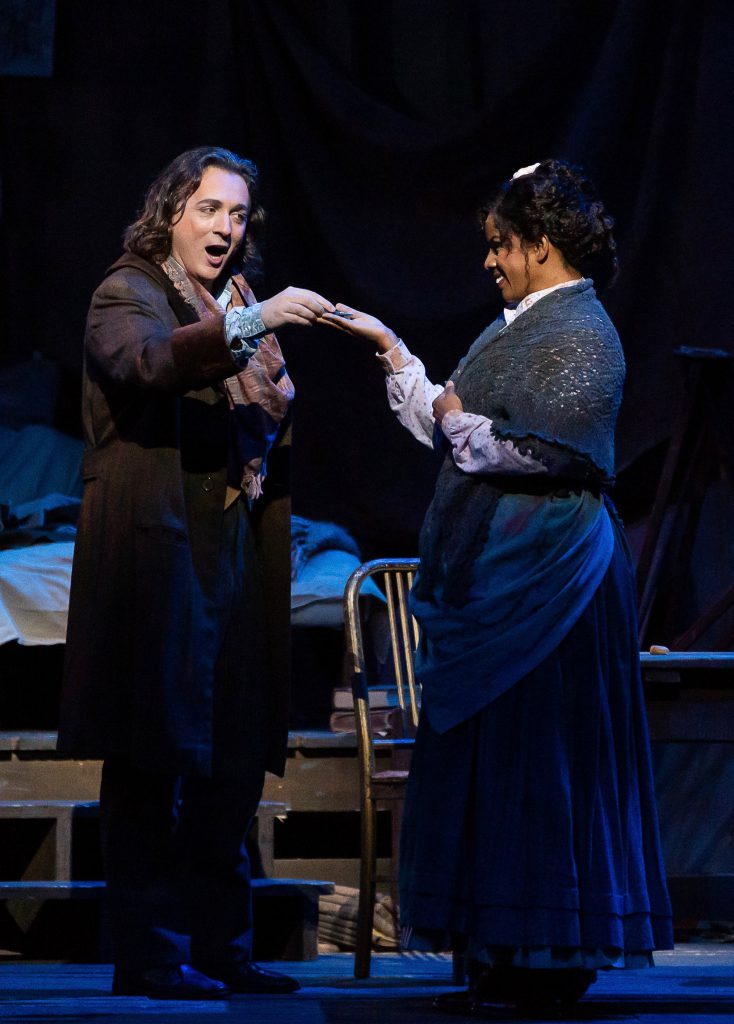Heaston’s Mimi and lively cast deliver the Puccininan warmth in HGO’s “Bohème”

Ivan Magri and Nicole Heaston star in Puccini’s “La bohème” at Houston Grand Opera. Photo: Lynn Lane
Houston Grand Opera’s production of La bohème makes a double contrast to its staging of The Flying Dutchman.
With Giacomo Puccini’s Bohème, HGO puts a realistic tale of young bohemians in Paris alongside Richard Wagner’s larger-than-life world of legend and Satanic curses.
The production’s styles differ, too. While Tomer Zvulun’s Dutchman sidesteps the traditional seaside village and sailing ships in favor of an industrial setting and expressionistic video projections, Bohème director John Caird take the audience into the familiar environs of the young artists’ garret and the Latin Quarter at Christmas time.
Yet while traditional, Caird’s production, which opened Friday night in the Wortham Theater Center, has freshened up Bohème at the same time. Taking a cue from the bohemian Marcello’s profession as a painter, director Caird and designer David Farley evoke the garret and the Christmas streetscape through masses of individual canvases, each depicting a portion of the vista. They’re clustered together to form the bulk of the sets, and a few hang in midair to reveal the Parisian skyscape in the background.
All this creates a kind of storybook aura for Mimi and Rodolfo’s romance. But in Act 3, where grim reality intrudes on the love affair, Farley creates an equally realistic depiction of the city gates and tavern, dusted with snow.
Friday’s performance also blended the familiar and the fresh. Caird’s staging preserved all the traditional stage business, from Rodolfo’s tearing up a manuscript–in sync with the music–and tossing it into the fire in Act 1 to the bohemians’ moving the bed to center stage in Act 4 for Mimi’s last goodbyes.
Yet Caird and the cast brought to the stage action such exuberance, naturalness and warmth that the well-known gambits retained their poetry and charm.
It was ultimately the cast that brought the story to life. At the center, soprano Nicole Heaston and tenor Ivan Magrì made a cozy and compelling pair as the lovers Mimi and Rodolfo.
Heaston went even beyond the poise and and warmth of her Adina in HGO’s 2016 staging of Gaetano Donizetti’s The Elixir of Love. LINK As Friday’s opening performance unfolded, Heaston’s voice surged and bloomed in Mimi’s lyrical outpourings. The one that climaxed the dying heroine’s last tête-à-tête with Rodolfo rang out the most ardently of all.
Magrì’s vocal palette didn’t include much Puccinian glow. But he sang with such brightness, vibrancy and security that Rodolfo’s flights of melody exuded youthful emotion.
Magrì and Heaston complemented the big moments’ electricity with the light, conversational coziness they brought to the music. In Mimi and Rodolfo’s first meeting, they gave Puccini’s music an aura of two people chatting to make acquaintance. Mimi’s duet with Marcello in Act 2 began like a simple, heart-to-heart talk. And Mimi and Rodolfo’s last scene together was suffused with affection and tenderness before it built up to the final flights of lyricism.
Rodolfo’s fellow bohemians made a spirited crew, thanks to their lively demeanors and hale-and-hearty voices.
As Marcello, baritone Michael Sumuel complemented Magrì’s bright tones with his darker voice. He also bellowed lustily during the name-calling outburst with Marcello’s on-and-off flame, Musetta.
Soprano Pureum Jo played Musetta with brashness galore. She brought Musetta’s waltz not only flamboyance, but touches of teasing lightness that exuded flirtatiousness in their own way. She then toned down in Act 4, where Musetta becomes more sympathetic.
Bass Federico de Michelis’ Colline balanced depth and gentleness in his Act 4 farewell to the coat headed to the pawnshop. As Schaunard, baritone Geoffrey Hahn sang with a resonance that fed into the comedy of his tale about dispatching his employer’s parrot.
The lot of them, as well as Magrì, threw themselves unabashedly into the bohemians’ horsing around, especially Act 4’s dance-off.
Baritone Héctor Vásquez did a neat switch of characterization. In Act 1, his Benoit settled into his chair to brag to the bohemians about his flair with women; in Act 2, his Alcindoro scurried around frantically, trying to placate the flighty Musetta.
Conductor James Lowe and the HGO Orchestra helped it all click, bringing clarity and vividness to bits of instrumental tone-painting that many groups gloss over.
The HGO Orchestra didn’t quite have the fullness of sonority to make the big lyrical moments–such as the swell of melody when Rodolfo spots Mimi in Act 3–exert their power. But Lowe and the group brought the music a transparency that enabled Heaston and Magrì to savor the music’s more intimate side.
And the orchestra did have enough power and gleam to reinforce the singers when their voices took flight. The sweep of the story’s emotions always came through, and that is a crucial element of a successful Bohème.
La Bohème runs through November 11 in the Wortham Theater Center. houstongrandopera.org; 713-228-6737.